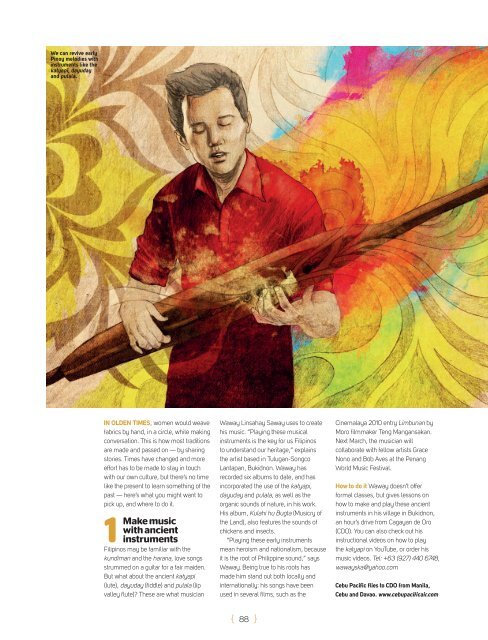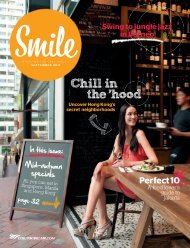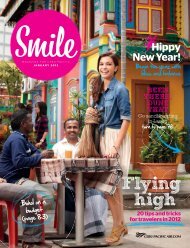december-2011
december-2011
december-2011
Create successful ePaper yourself
Turn your PDF publications into a flip-book with our unique Google optimized e-Paper software.
We can revive early<br />
Pinoy melodies with<br />
instruments like the<br />
katyapi, dayuday<br />
and pulala.<br />
IN OLDEN TIMES, women would weave<br />
fabrics by hand, in a circle, while making<br />
conversation. This is how most traditions<br />
are made and passed on — by sharing<br />
stories. Times have changed and more<br />
effort has to be made to stay in touch<br />
with our own culture, but there’s no time<br />
like the present to learn something of the<br />
past — here’s what you might want to<br />
pick up, and where to do it.<br />
1<br />
Make music<br />
with ancient<br />
instruments<br />
Filipinos may be familiar with the<br />
kundiman and the harana, love songs<br />
strummed on a guitar for a fair maiden.<br />
But what about the ancient katyapi<br />
(lute), dayuday (fi ddle) and pulala (lip<br />
valley fl ute)? These are what musician<br />
Waway Linsahay Saway uses to create<br />
his music. “Playing these musical<br />
instruments is the key for us Filipinos<br />
to understand our heritage,” explains<br />
the artist based in Tulugan-Songco<br />
Lantapan, Bukidnon. Waway has<br />
recorded six albums to date, and has<br />
incorporated the use of the katyapi,<br />
dayuday and pulala, as well as the<br />
organic sounds of nature, in his work.<br />
His album, Kulahi hu Bugta (Musicry of<br />
the Land), also features the sounds of<br />
chickens and insects.<br />
“Playing these early instruments<br />
mean heroism and nationalism, because<br />
it is the root of Philippine sound,” says<br />
Waway. Being true to his roots has<br />
made him stand out both locally and<br />
internationally: his songs have been<br />
used in several fi lms, such as the<br />
{ 88 }<br />
Cinemalaya 2010 entry Limbunan by<br />
Moro fi lmmaker Teng Mangansakan.<br />
Next March, the musician will<br />
collaborate with fellow artists Grace<br />
Nono and Bob Aves at the Penang<br />
World Music Festival.<br />
How to do it Waway doesn’t offer<br />
formal classes, but gives lessons on<br />
how to make and play these ancient<br />
instruments in his village in Bukidnon,<br />
an hour’s drive from Cagayan de Oro<br />
(CDO). You can also check out his<br />
instructional videos on how to play<br />
the katyapi on YouTube, or order his<br />
music videos. Tel: +63 (927) 440 6748,<br />
wawayska@yahoo.com<br />
Cebu Pacifi c fl ies to CDO from Manila,<br />
Cebu and Davao. www.cebupacifi cair.com














